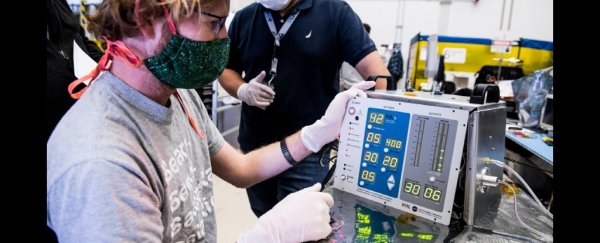NASA engineers have designed a mass-producible ventilator tailored to coronavirus patients, and it could get emergency approval from the Food and Drug Administration by the weekend.
A team of engineers at the Jet Propulsion Laboratory in Pasadena, California, designed and built the ventilator in just 37 days. The device, called VITAL as an acronym for Ventilator Intervention Technology Accessible Locally, uses one-seventh the number of parts required for a conventional ventilator. That would make it easier to mass produce quickly.
NASA administrators said they would offer a free licence to help get the device into hospitals faster. That could help emergency-response departments prepare for future influxes of COVID-19 patients, which experts expect to see once lockdowns across the country begin to lift.
"Intensive-care units are seeing COVID-19 patients who require highly dynamic ventilators," Dr. J.D. Polk, NASA's chief health and medical officer, said in a press release.
"The intention with VITAL is to decrease the likelihood patients will get to that advanced stage of the disease and require more advanced ventilator assistance."
A prototype of the ventilator was tested at the Icahn School of Medicine at Mount Sinai in New York, where the school's Human Simulation Lab simulated a range of patient conditions.
"The testing was outstanding," Dave Gallagher, a JPL associate director who worked with the team, said in a press call on Thursday.
The team has submitted an application for emergency-use authorization from the FDA, Gallagher said, and expects approval within 48 hours.
NASA improvised parts to avoid supply-chain issues
To avoid disrupting the supply chain for conventional ventilators, which have already been in short supply, NASA's engineers opted for a design that requires fewer parts than a conventional ventilator and relies on different machinery.
"They're really parts from other industries that can be used with this application," Gallagher said.
The hope is that manufacturers could produce the device without detracting from the production of conventional ventilators.
"They're not parts that you would normally necessarily use in building up a ventilator," Polk said in the briefing. "There's close to 700 parts out there that we're not using and not having to compete with the supply chain."
Though the officials did not offer an exact cost for producing the ventilator, Gallagher estimated that it would be roughly $US2,000 to $US3,000. For comparison, General Motors is producing low-cost ventilators for the national stockpile at more than $US16,000 apiece.
 Some of the engineers involved in creating the ventilator prototype. (NASA & JPL-Caltech)
Some of the engineers involved in creating the ventilator prototype. (NASA & JPL-Caltech)
Preventing ventilator shortages in the next waves of COVID-19
Though many cities, counties, and states across the US seem to have passed the peaks of their first waves of coronavirus cases, experts expect COVID-19 to remain a problem until a vaccine is approved. As local governments loosen restrictions, business open, and people start to mingle again, the virus will spread.
Experts say that will bring new waves of infection, which can get out of control if they aren't closely monitored and cut short with additional lockdowns.
Any place where these subsequent waves of infection overwhelm local hospitals could see ventilator shortages.
That's what almost happened in New York City in late March and early April. In Italy, ventilator shortages have been so bad that doctors have described having to decide which patients to prioritise for the treatment.
"The one horrific decision I never want to have to make is who gets a ventilator and who doesn't," Dr. Hooman Poor, a physician at Mount Sinai, previously told Business Insider. "That's a horrifying situation."
If NASA's new device can be widely produced and distributed across the globe – still two big ifs – it could prevent that situation from arising again.
"It's a crazy project," Michelle Easter, an engineer on the JPL team that designed the ventilator, said in a NASA video. "We have the potential to save human lives, people that we might know, our neighbours, our families."
Yeji Jesse Lee contributed reporting.
This article was originally published by Business Insider.
More from Business Insider:
